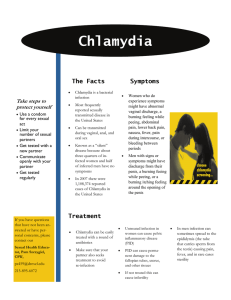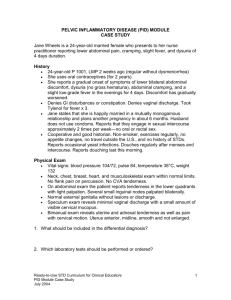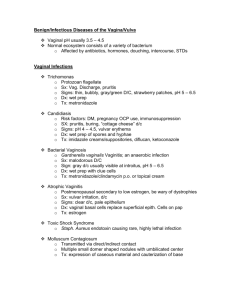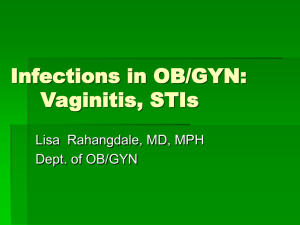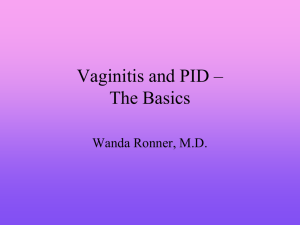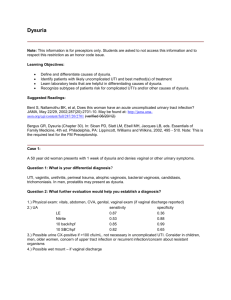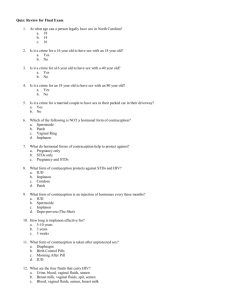Sexually Transmitted Infections Terra Safer, MD Internal Medicine/Pediatrics Associate Clinical Professor
advertisement
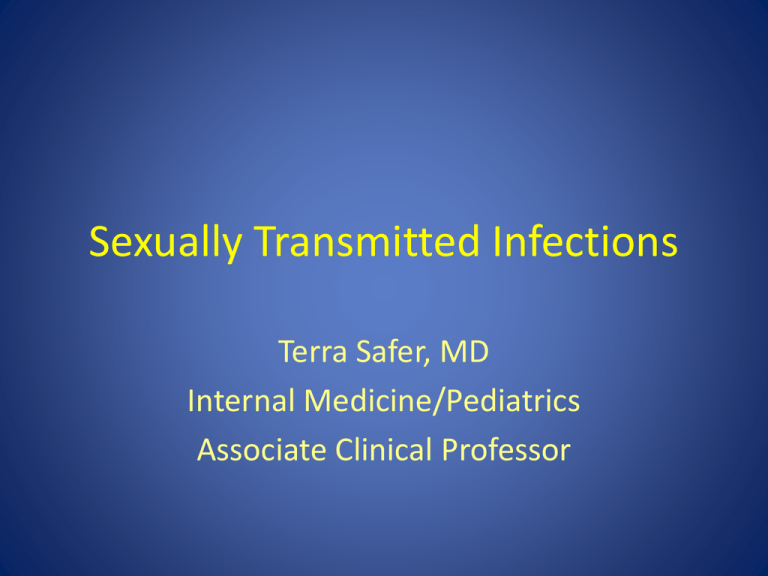
Sexually Transmitted Infections Terra Safer, MD Internal Medicine/Pediatrics Associate Clinical Professor Patient case • 72 yo F with hx HTN here for annual physical. • In regards in GYN/GU history: no vaginal d/c, itch nor odor. No vaginal bleeding. • Social hx: Patient is married but… Learning Objectives • Understand epidemiology/burden of STI – Adolescents • Differentiate between different STI – Clinical presentation – Diagnostic testing – Treatment • Know Screening guidelines Epidemiology • Sexually transmitted infections (STIs) cause significant morbidity and mortality in the United States each year. • CDC estimates 19 million new infections/yr in US – almost one half of which occur in 15 to 24 yo • Estimated 2.8 million new chlamydia infxn • 1.6 million new genital herpes infxn Risk to Adolescents • 40% of Chlamydia and Gonorrheal infxn/yr in adol • ½ of people<25 yo have STI • Behavior – Early intercourse • 47% reported sexually active by the end of high school (down) – – – – Multiple partners (with multiple partners) New partners Inconsistent condom use Alcohol/drug use • Biology – Cervical ectopic/immaturity STI • Ulcers – Syphilis – Herpes Simplex – Lymphogranuloma venereum – Chancroid • Other – HPV – HIV • Discharge – Gonorrhea – Chlamydia – Nongonococcal nonchlamydial urethritis and cervicitis – Trichomonias – Candida – Bacterial vaginosis Gonorrhea • Sx: within 10 days of exposure F; 1-14d M • F: up to 70% asx, dysuria, vaginal/urethral d/c, pruritus, intermenstrual bleed, pelvic pain • M: up to 60% asx or mild sx, swollen testes, penile d/c, dysuria, epididymitis (unilateral) • Throat and rectum • PID • Bacteremic/disseminated – purulent arthritis or triad tenosynovitis, dermatitis, polyarthralgia • Dx: • Exam: Mucopurulent d/c from cervix, friable cervix • PAP or swab or urine NAAT; GS; • check chlamydia Gonorrhea • Gram Stain: PMN with intracellular Gram neg diplococci • Culture – if resistance suspected; – if cont sx post treatment • Tx: Increasing resistance: ceftriaxone 250mg IM x1 azithromycin 2nd line – – – – No need test for cure Retest 3 months Expedited partner therapy: oral cefixime and azithromycin for GC Chlamydia • Sx: often ax—85% female and 40-96% male • F: burn/pruritus of GU, d/c, dysuria, abnl vaginal bleeding • M: mucoid watery urethral d/c and dysuria, – freq cause epididymitis <35yo, may cause chronic prostatitis • Complications: PID; can affect the throat or rectum • Dx: exam: 10-20% abnl exam; mucopurulent endocervical d/c; easy to bleed or edematous cervix • NAAT of vaginal swab or urine • Tx: Azithromycin 1g x1 or doxycycline 100mg bid x 7day • No need test for cure unless pregnant or cont with sx Pelvic Inflammatory Disease • Acute infection of upper female genital tract structure including uterus, oviducts, ovaries • Risk: hx of PID; adol 50% more likely to recur • Cause: GC, Chlamydia, nl vaginal flora including enteric Gram neg rod, Strep, Gardnerella may play role – Up to 10% untreated GC and 20% unrx Chl dev PID • Sx: lower abdominal pain with new vaginal d/c, dysuria, painful defecation, f/c, perihepatitis Fitz Hugh Curtis Syndrome • Perihepatitis: infxn of liver capsule and peritoneal surfaces of anterior RUQ • Patchy purulent and fibrinous exudate in acute phase (violin string adhesions) affecting primary ant surface of liver (not parenchyma) • Sx: sudden severe RUQ pain with distinct pleuritic component, sometimes to R shoulder • LFT normal or sl increased PID • CDC minimal CRITERIA: CMT or uterine or adnexal tender – supportive dx: fever with cervical/vaginal d/c with lower abd/pelvic pain • Lab: ESR, WBC, microexam, Cervical cx, bHCG and u/a, HIV • Pelvic US for acutely ill to r/o abscess • Complications: tubo ovarian abscess, infertility, chronic pelvic pain, ectopic preg • Risk complication increase with # episodes and severity of PID – Infertility increased with Chlamydia, delay in rx, number of PID – Rx may NOT prevent long term sequellae scarring and adhesions with healing TREATMENT OF PID with broad spectrum abx with anaerobic coverage if recent instrumentation or severe/complicated PID (abscess) Inpt severe/complicated: 2nd generation cephalosporin cefoxitin or cefotetan and doxy OR clinda and gent, oral post 24 hr improved Oupt: Ceftriaxone 250mg IM and doxy x 14 days, recheck 72 hrs (+/- flagyl) Trichomoniasis • Protozoa: Trichomonas vaginalis • Sx: F: 50% asx; yellow green thin d/c and odor, itch or burning vaginal, pain with intercourse, dysuria • M: asx, minor d/c or dysuria/urethritis • 5-28 day post infection sx develop • Dx: Exam: abnl d/c with strawberry cervix • Wet Mount: motile trichomonads, hi pH and PMNs • Culture, NAAT testing • Tx: metronizadole 2gm or tinidazole 2gm x1 • Untreated: urethritis, cystitis, atypical PID, infertility, more susceptible to HIV, preterm labor/low birth wt Trichomonas vaginalis Bacterial Vaginosis • Polymicrobial clinical syndrome • Change normal vaginal flora with decrease nl H2O2 producing lactobacilli • Increase other organisms—esp Gardnerella vaginalis • Sx: 50-75% ax; off white, creamy or foamy thin malodorous (fish smelling) discharge – increase post SA and in menses • Dx: 3 of 4 Amsel criteria: – – – – clue cells >20% of epi cells on wet mount; homogenous thin gray white d/c coating vaginal walls; pH >4.5 vaginally; +whiff amine test: fishy odor when 10% KOH added Nl wet mount vs clue cells Bacterial Vaginosis • Tx: Metronidazole 500 bid x 7day or gel 0.75 qhs x 5 days; Clindamycin • 30% recur within 3 months, 50% recur within 12 months • Relapse: change abx, longer course, boric acid; metronidazole 2/week x 4-6 mos • Complications: preterm labor; birth risk, plasma cell endometritis, postpartum F, post abortion infection, PID, increase risk other STI Candidiasis • Normal flora but overgrowth and penetration of superficial epithelial cells • Candida albicans 80-92% of vulvovaginitis – C glabrata next common • Sx: vulvar pruritus (main), vulvar burning, soreness, irritation, dysuria, dyspareunia • Dx: exam: vulva and vaginal erythema, excoriation and fissures with d/c: little or white, thick adherent, clumpy with minimal odor • Candida on wet mount or GS or culture – Cx if persistent, recurrent sx (nonalbicans resistant to azoles) • Tx: asx no req rx, no rx partner • Uncomplicated: <3/yr, mildmod sx, C albicans, nonpreg (>80%) – oral and topical comparable cure Fluconazole 150mg x1 • Complicated: DM, preg, immunosuppressed, debilitated – fluconazole 150mg q3 day x2 – C glabrata boric acid x 2 weeks • Recurrent: (>4/yr): suppress fluconazole 150mg q3day x 3 then qwk x 6 months Syphilis • Chronic infxn by spirochete Treponema pallidum • Stages: early, 1, 2, early latent: within first yr – latent: asx with + serology • Primary: Chancre: painless ulcer with mild/mod regional LAD (unnoticed 15-30%) • Secondary: Hematogenous dissemination – systemic sx: malaise, fever, HA – rash on soles of feet/palms/body; hair loss – Condylomata lata (grey moist raised patch) Treponema pallidum Primary Syphilis Secondary Syphilis Secondary Syphilis Late/Tertiary Syphilis • 3-10 yrs post initial infection • Gummatous syphilis: involve any body part • skin (ulcerative lesion), bone, internal organ (like mass), CV (aortic root leading to AI, coronary art involvement can lead to thrombosis and MI) – PCN G 2.4 million U qwk x 3 wk • Neurosyphilis: invasion of CSF • meningitis, general paresis, tabes dorsalis, meningovasc dz – Dev post 1 yr up to 25 yrs later – Treatment PCN G 24 million U/day x 14 days Argyll Robertson Pupil Syphilis • Dx: Clinical, Darkfield, Serologic testing • Nontreponemal: semiquantative, titer of Ab – RPR, VDRL – Height of Ab=activity of dz, follow with treatment • Treponemal test: either reactive or nonreactive – once +, stays for extended time; FTA antibodies • Tx: benzathine PCN G 2.4 million U once • Late latent or unknown: 3 doses weekly of above • Severe PCN all: doxy or azithromycin Syphilis • Post rx: test clinical, serologic at 6, 12 mos – four fold decrease in titer of nontrep= +response • If no appropriate decline in titer, another course of PCN and check HIV and LP • Jarish-Herxheimer rxn: Acute febrile reaction with HA, myalgia within 24hr of rx with PCN (more common with early syphilis) – supportive treatment Chancroid • Hemophilis ducreyi, small fastidious Gm neg rod • Rare in US: Africa and Asia • Sx: painful lumps in GU that progress to open sores (deep undermined purulent ulcer) with LAD – Infected LN: buboes • Incubate 4-10 days (range 1-35 days) • Dx: sx since special media for cx needed – Also check HSV, RPR • Tx: Azithromycin 1gm or CTX 250mg • Buboes may require surgery to drain Herpes Simplex Virus • Direct contact, genital: HSV 2 (60-70%) • Sx: Vesicles into painful ulcerations then, crusted sores on GU area/buttock/thigh, anus • Primary infxn: painful ulcers with constitutional sx or mild/asx • Clinical recurrence genital HSV common but less severe • Asx intermittent shedding without lesions • Increase risk HSV acquisition with male source partner • Dx: confirm by PCR, viral cx; serology HSV treatment • Antiviral: famciclovir and valacyclovir have improved bioavailability vs acyclovir • >6 recurrence/yr and/or severe sx: chronic suppressive antiviral (<6 or mod sx, episodic antiviral rather than chronic) – lysine • 50% on suppression remain recurrence free, others 70-80% decrease freq recurrence and less asx shedding – Patient considerations: psychosocial, adherence, cost, risk to uninfected partner Lymphogranuloma Venereum • Chlamydia trachomatis serovars L1, L2, L3 • In tropical and subtropical areas • Sx: Ulcer at site of inoculation then lymphoproliferative rxn with direct extension from primary infxn site to draining LN – fever, HA, anal sores, rectal d/c or pain or bleed/proctitis (anal sex) • Dx: cx low yield; serology low specificity; NAAT for LGV • Tx: doxy 100mg bid x 21 day or azithromycin 1 gm qwk x 3wk • Buboes may require I&D/aspiration to avoid sinus tract/rupture Human Papilloma Virus (HPV) • Small double stranded DNA virus • Only infect humans with skin to skin • Associated with squamous neoplasia of anogenital region and oropharynx • No need to have sexual intercourse to get • Type 16-18 70% of cervical cancers (16: 60%) • Type 6,11 90% of genital warts HPV • Dx: Clinical, Cytology, NAAT – Acetic Acid, Colposcopy (acid, green filter, iodine) • • • • Tx: Wart: chemical destruction Provider destructive (cryo, electrocautery) Colposcopy: biopsy Prevention – Gardasil Quadrivalent Vaccine 6,11,16,18 – Cervarix Bivalent 16,18 • 25 yo F presents with change in vaginal d/c with itch and odor. • On exam there is thin gray d/c vaginally with fish odor… • Bacterial Vaginosis • 60 yo M presents with rash that has developed on his palms and soles. Also noticed hair loss recently which he assumed was due to his age… • Secondary Syphilis • PCN 20 yo M presents with hot red swollen knee. Gonorrheal arthritis • 24yo male present with right testicular pain. • On exam you notice swelling and pain over the epididymis. • Which 2 organisms do you need to treat while awaiting results of testing? • A. Gonorrhea • B. Treponema • C. Chlamydia • D. Gardnerella • E. Trichomonas 30 yo M notices ulcer on penis, painless. If not treated, what can the patient expect? A. Recurrence B. Enlarging LN C. Body rash • 18 yo F presents for her annual exam. Patient has no complaints, specifically no vaginal d/c, itch, odor nor dysuria. • On exam you notice • Trichomonias • 32 yo M presents with complaints of painful lesions on his penis. • What treatment would you offer him? • Valacyclovir • 62 yo M presents in clinic since his wife stated his pupils look different. • On exam his pupil does not react to light on the right, but does accommodate. • Treat with PCN G x 3 doses weekly
